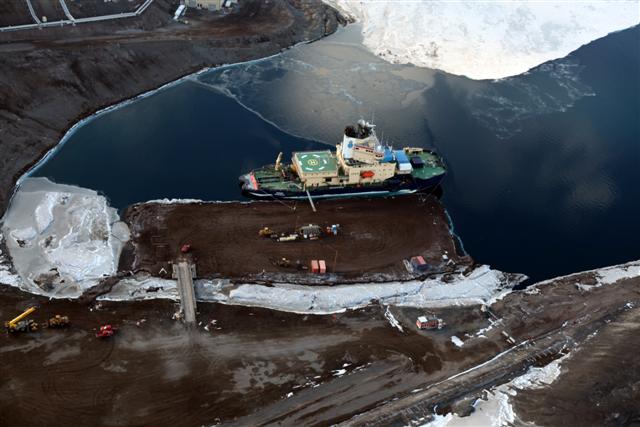Two ships, one missionResearch cruise pairs U.S., Swedish vessels on 3,000-mile-long journeyPosted November 26, 2010
It’s not the fastest route to reach McMurdo Station The Swedish icebreaker Oden “Imagine driving across the United States at 12 miles per hour. That’s basically what we’re doing,” said Patricia Yager Related Articles
Yager is the lead principal investigator on the ship-based project called Amundsen Sea Polynya International Research Expedition (ASPIRE). The ASPIRE project brings together a multidisciplinary group of mostly Americans and Swedish scientists to study an area of open ocean surrounded by ice that is the most biologically active polynya in the Southern Ocean. The Palmer is scheduled to leave Punta Arenas at the end of November, carrying both the ASPIRE team and a second group interested in learning more about invasive crabs that appear to be moving into more shallow areas, possibly threatening organisms on the continental shelf that have evolved without such predators over tens of millions of years. The ship will first make its way to Marguerite Bay in the middle of the Antarctic Peninsula, where a species of king crabs has been previously spotted on the continental slope. The Palmer will then head farther south, eventually rendezvousing with the Oden to swap scientists. The team hunting for invasive crabs, a project led by Richard Aronson and James McClintock It’s a rare pairing of two polar research vessels, according to Addie Coyac, a science planning manager for Raytheon Polar Services (RPSC) 
Photo Credit: Peter Rejcek/Antarctic Photo Library
The research vessel Nathaniel B. Palmer at the pier in Punta Arenas, Chile. Across the way is a British research ship.
Primarily an icebreaker capable of cutting through about 2 meters of ice at 3 knots, the Oden serves as the muscle on this expedition. While the two ships will work on separate projects for the most part, the Oden will be available to escort the Palmer into the polynya should the surrounding sea ice prove too stout. The Palmer is also an icebreaker but not of the Swedish ship’s strength. “It will be interesting to see what the ice does this year and how it works out,” Coyac said. Since 2007, the NSF has had an agreement with the Swedish Polar Research Secretariat The ship’s unique hull design (it is shaped like a flat-bottomed skiff) allows it to break ice not by smashing into it, but rather by riding up onto it and using the ship’s weight to crack it. In addition, a pump system quickly moves hundreds of tons of water within the Oden from one side to the other, rocking the ship in heavy ice so that the reamers break the ice at the sides of the ship. The Oden is also a research vessel, so American and Swedish scientists have used it previously for various projects. However, this year researchers were encouraged to submit collaborative proposals, meaning both ships will carry large contingents of U.S. and Swedish investigators working on similar projects. “It’s a great opportunity to do international and multidisciplinary science to understand a changing ecosystem. That’s what I’m excited about,” Yager said.1 2 Next |



For USAP Participants |
For The Public |
For Researchers and EducatorsContact UsU.S. National Science FoundationOffice of Polar Programs Geosciences Directorate 2415 Eisenhower Avenue, Suite W7100 Alexandria, VA 22314 Sign up for the NSF Office of Polar Programs newsletter and events. Feedback Form |


